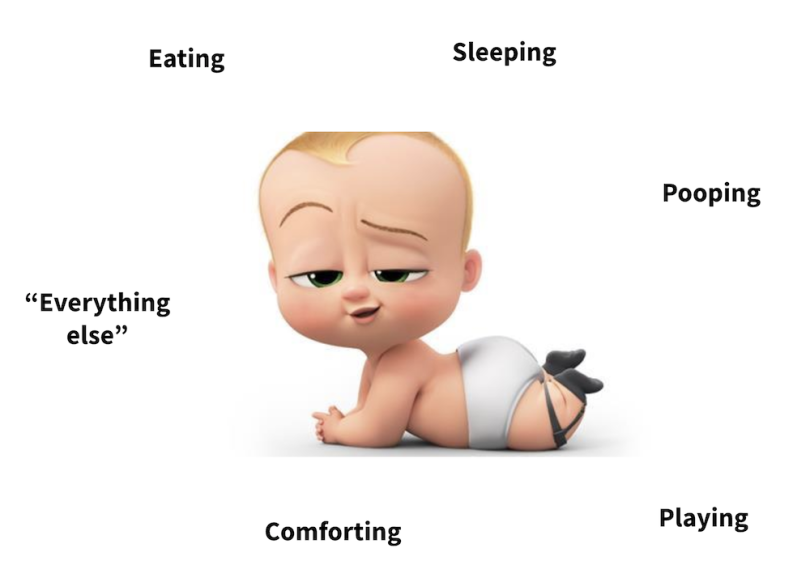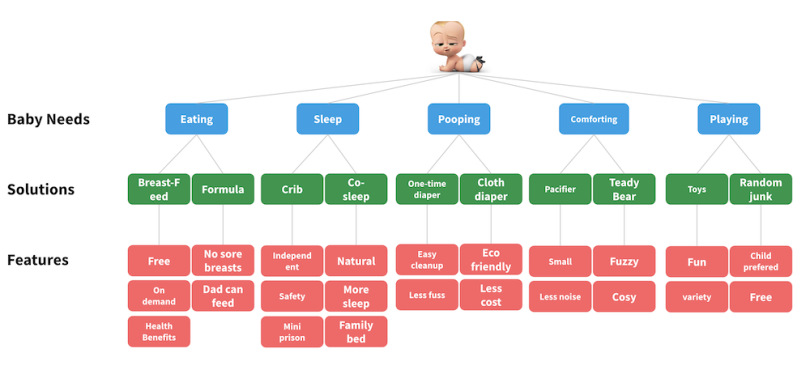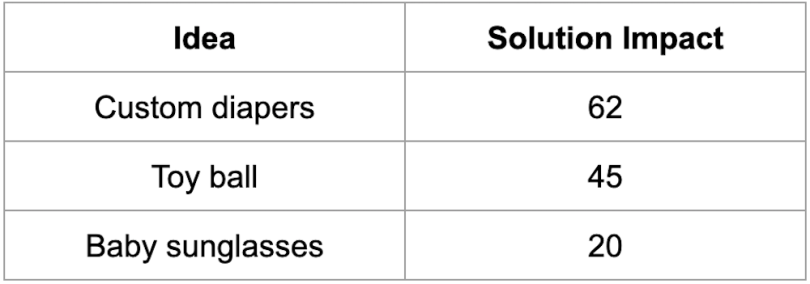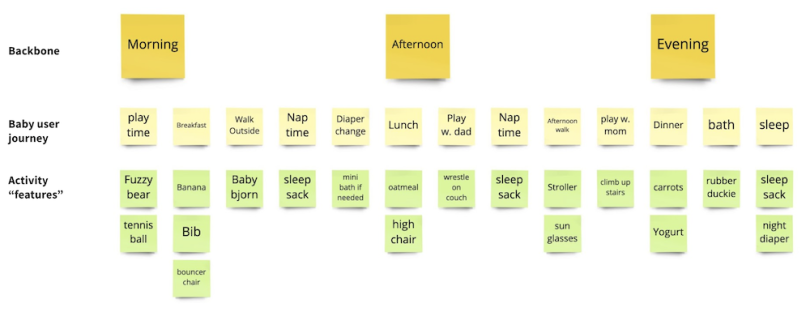In my first article on parenting like a product manager, we covered how to understand your baby customer. Today we will keep building upon our foundation and talk about identifying customer needs, creating a “baby tree” to select the best solutions for those needs, and prioritizing them. Finally, we will help you control the daily chaos by story-mapping your baby’s activities.
A Dad’s Perspective on Customer Needs
As I mentioned, baby needs are basic relative to adult needs. From my oversimplified dad’s perspective, I can place these needs down into one of five buckets:

Eating — These little energy balls need fuel to power their engine.
Sleeping — When your baby is growing like crazy, he or she will need a lot of sleep, especially in the first couple of months.
Pooping — Everybody poops.
Playing — This is how children develop many motor, language, and social skills.
Comforting — We all need a little bit of love once in a while, and so does your baby. Be generous with the hugs and kisses.
That’s it! Now, some people may argue that a baby has more needs than this. You will be influenced by family, friends, and the internet. Companies will try to sell you other baby needs, e.g., how your baby needs a meditation tree to find their inner Zen. In my mind, these are pseudo-needs and created by marketing or emotion rather than science and logic. We can lump these needs into an “everything else” bucket for now and save them for a rainy day. Let’s put on our product manager (PM) hats and try to address these five customer needs.
The Baby Tree Framework
Now that we have identified our customer’s needs, we want to start ideating solutions to these needs and understand the different features of each solution. Enter the baby tree framework.

At the top level of our baby tree, we find the five baby needs previously identified. Next, we will map our different solutions for the baby’s needs at the second level. When brainstorming, you may come up with many ideas, but try to pick your top one to three solutions per need. Great work! We’re on a roll.
Next, we can map out all the features for each solution. Don’t think of these features exclusively as benefits since they may also highlight the disadvantages of a solution.
Let’s walk through an example. In our framework under the eating need, we listed breastfeeding and formula as two solutions (let’s assume we are talking about a newborn infant). The features of breastfeeding are that it is free, it is on-demand (no food preparation is necessary), and there are health benefits associated with breastfeeding. For formula, the features are that the breastfeeding partner won’t have sore breasts, and the non-breastfeeding partner can also participate in the feeding. Next, you can talk through the features of each solution with your partner and pick the solution that works for you!
The beauty of the baby tree framework is that it allows you to visualize solutions and features and make a more rational decision about what will work best for your family. One of the challenges with being a new parent is being constantly stressed. It’s hard to make a good decision at 3 a.m. when your baby has been up all night. Creating a baby tree framework will hopefully minimize the number of Amazon panic purchases you make in the middle of the night.
When considering solutions for our baby’s needs, we should also ask ourselves if we should try to solve all problems for our child. There is a good kind of struggle that encourages motor skills and cognitive development, and parents should use common sense to identify those situations. We also need to consider the cost of our solutions (for example, more expensive is not always better) and acknowledge different customs and traditions in child upbringing in various cultures around the world.
Prioritization With BBUCC
We mapped out the baby’s needs and used the baby tree framework to identify solutions to those needs. The problem is that now we have many solutions, and we may not know where to start. As parents, we’re already stressed, and it’s easy to focus on the wrong thing and address needs that are not crucial right now.
As PMs, we love to use various frameworks and try to quantify a product feature’s value to help us prioritize what will deliver the most impact. We can do the same type of quantitative prioritization of our baby solutions and identify what’s most important right now. We will use to BBUCC framework to do this.
BBUCC Framework for Parenting Like a Product Manager
- Baby Development — Does the solution contribute to your baby’s development?
- Baby Happiness — How happy will this solution make your baby?
- Urgency — Do you have to solve this need right now?
- Confidence — How confident in the solution are you? How much research have you done?
- Cost — Is this a cheap or expensive solution?
For baby development, baby happiness, urgency, and confidence you will score the solution one (low), three (medium), or five (high). When scoring the cost the scale inverts; five (not expensive), three (average cost), and one (very expensive). To calculate a prioritization score for the solution relative to others, you simply multiply all the categories together. A higher score means that solution will deliver more impact.
Solution impact = BxBxUxCxC
Let’s look at an example. Say I am trying to determine if I should buy a toy ball for my six-month-old baby. Using the framework, I decided that the ball contributes to medium baby development (three), it won't provide much happiness at this young age (one), it is not an urgent solution (one), I have done some research to verify this (three), and it's an inexpensive solution (five). Using BBUCC I get:
Solution impact = 3x1x1x3x5 = 45
I can now stack rank this to other solutions that I have scored with BBUCC.

We can see that, in our example, the framework shows us that getting custom diapers is more important for our baby's needs. In practice, you may find it hard to find the time to create these prioritized lists, but at the minimum, you should be thinking about these five categories when making decisions on what to purchase for your baby.
Story Mapping Your Baby’s Day
To be a successful parent, you have to be prepared for situations as they pop up throughout the day. This is very hard in the beginning when you are baby’s schedule seems to change almost every day, but over time, you will start finding your daily routine.
Story mapping a baby’s user journey throughout the day is a very effective technique to ensure you have the right tools for the baby’s needs during the day. Take a look at the story map below:

First, we create the backbone by dividing the day into morning, afternoon, and evening. Next, we map out the baby's user journey throughout the day. If you are working as a team of two parents, you can tag each task with who is responsible for supervising.
Finally, we can map out what features are necessary to enable each baby user task. In practice, features will be different activities or items required to complete the specific baby task. Let’s look at a few examples. For lunch, we identified that we need oatmeal and a highchair. For the afternoon walk, we will need the stroller and sunglasses. Story mapping the baby’s day allows you to stay one step ahead of the game by visualizing what you need to keep your little one happy.
Wrapping Up
Once again, we have proven that we can use the skills and tools of a PM in a new way to make parenting a little easier. But we’re not finished: In part 3, we will talk about execution, agility, and customer feedback. Check back soon for part three of parenting like a product manager.





